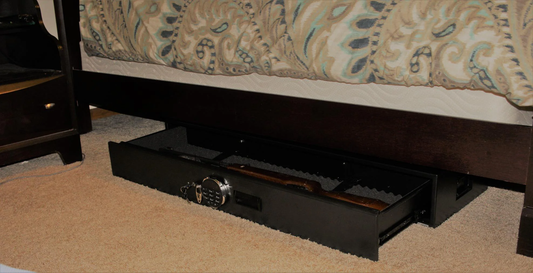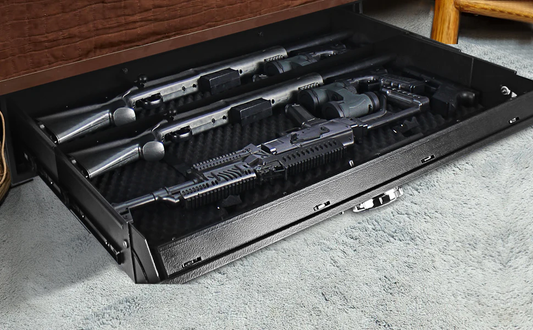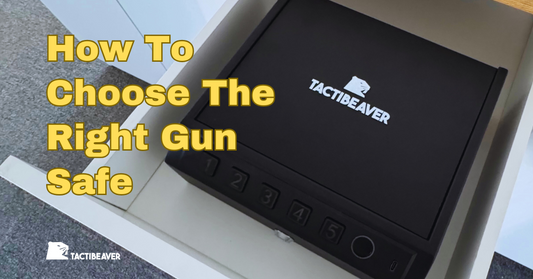Firearm safety is a solemn duty that rests on the shoulders of every gun owner, whether you're a seasoned enthusiast, a dedicated collector, or a first-time buyer embarking on your journey into the world of firearms. Central to this responsibility is understanding when a firearm should be unloaded, a knowledge that is more than just a procedural step—it’s a fundamental aspect of cultivating a responsible and safety-oriented mindset. At TactiBeaver, we understand that this knowledge not only prevents potential accidental discharges but also ensures the well-being of everyone in your vicinity, reinforcing the importance of a diligent approach to handling firearms.
Understanding the Imperatives of Unloading Firearms
Firearms, while versatile and powerful tools, can precipitate tragic consequences if mishandled. A consistent theme in firearm safety education is the imperative of unloading firearms properly. According to various studies on firearm safety, such as those conducted by the National Rifle Association (NRA), many accidents stem from firearms being improperly checked or neglected, leading to unintended discharges that could otherwise be prevented. This underscores the critical importance of rigorous procedural compliance—ensuring each unloading process is executed with meticulous care.
By consistently ensuring that firearms are not left loaded, owners are not just preventing potential accidents, but they are also maintaining the operational integrity of the weapon. Ammunition, when left in the chamber or magazine for prolonged periods, can contribute to the deterioration of gun parts, consequently affecting its overall performance. By routinely unloading your firearm when not in active use, you embrace proactive stewardship, preserving its functionality and longevity—an approach TactiBeaver advocates for all responsible gun owners.
US Federal and State Laws on Firearm Unloading
First, understanding and complying with federal and state laws regarding firearm unloading is crucial for responsible gun ownership. While federal laws provide a baseline, individual states often have additional requirements that gun owners must follow.
Federal Laws:
The Gun Control Act of 1968 and subsequent amendments primarily focus on firearm sales, transfers, and possession rather than specific unloading regulations. However, federal law does require firearms to be unloaded in the following typical circumstances:
-
Transportation on commercial aircraft: Firearms must be unloaded, declared, and stored in checked baggage.
-
Military bases: For civilians authorized to bring firearms onto a military installation, the weapons typically must be unloaded and secured.
-
Native American reservations: While laws can vary by tribe, many require firearms to be unloaded when transported through reservation lands.
-
Federal Wildlife Refuges: Regulations often require firearms to be unloaded when transported in vehicles within refuge boundaries.
-
Interstate transportation: The Firearm Owners Protection Act provides a safe harbor for interstate transportation of firearms, provided the firearms are unloaded and neither the firearms nor ammunition are readily accessible from the passenger compartment.
State Laws:
State laws vary significantly and may include more specific requirements for unloading firearms:
-
At Home:
- Massachusetts: Requires firearms to be stored unloaded and locked when not in use.
- California: Mandates that firearms be stored unloaded and locked when children are likely to be present.
- New York: Requires firearms to be locked or safely stored unloaded if living with someone prohibited from possessing firearms.
-
During Transportation:
- California: Firearms must be unloaded and locked in the vehicle's trunk or in a locked container when transported in a car.
- Massachusetts: All firearms must be unloaded and secured in a locked container or equipped with a tamper-resistant mechanical lock during transportation in any vehicle.
- Alaska: State law requires firearms to be unloaded when transported on any aircraft, including small private planes.
-
In Shooting Places:
- Many states require firearms to be unloaded when not actively in use at shooting ranges.
- Colorado: Mandates that firearms be unloaded when not on the firing line at public shooting ranges.
- Washington: Requires firearms to be unloaded when not in use at public ranges.
-
Other Specific Situations:
-
Oregon: Requires firearms to be unloaded in public buildings and at public meetings.
-
Wisconsin: Mandates that firearms be unloaded in school zones.
-
Michigan: Requires firearms to be unloaded in designated safety zones around homes, buildings, and recreation areas during hunting seasons.
It's crucial to note that these laws can vary significantly between states and may change over time. Some states have more permissive laws, while others are more restrictive. Always check the most current local and state regulations, and consult with legal professionals for the most accurate and up-to-date information specific to your area.
Essential Scenarios for Unloading Firearms
Besides law regulation, understanding the common situations when a firearm should be unloaded is as crucial as developing proficiency in handling one. Let's delve into essential scenarios where unloading becomes imperative:
-
After Use: Post-usage, whether at a shooting range or after a hunting session, unloading your firearm is vital. By making this a habitual practice, you inherently minimize the risk of accidental discharges during transport or subsequent handling. As per insights from experts at The Gun Zone, this is among the most effective preventive strategies a gun owner can employ.
-
Before Storing: Always ensure firearms are stored unloaded. This action is vital for preventing unauthorized access and mitigating accidental firing risks. At the Remington Safety Center, experts stress the necessity of this step as a core safety measure, which aligns with TactiBeaver's commitment to firearm security.
-
Before Cleaning: A loaded firearm can turn routine maintenance into a hazardous activity. By unloading before cleaning, you eliminate the risk of accidental discharges, a practice emphasized by Hunter-Ed training programs.
-
When Transporting: Transporting a loaded firearm not only poses significant safety risks but may also lead to legal repercussions in various jurisdictions. By ensuring your firearm is unloaded before placing it in a vehicle or carrying it through public spaces, you align with legal standards and promote safety.
-
Before Handing to Someone Else: Whether you’re passing your firearm to a friend, a family member, or a professional, always ensure it is unloaded beforehand. This practice eliminates the risk of accidental discharges during transfer, a principle regularly underscored in safety workshops.
-
In Uncertain Environments: Navigating uncertain terrains—such as crossing slippery surfaces, climbing, or traversing through aquatic environments—calls for additional precautions. By unloading your firearm in these scenarios, you significantly mitigate accidental firing risks due to environmental variables, as highlighted by EasyShot Targets' safety analyses.
Through these scenarios, the critical overlap of vigilance and practical firearm knowledge becomes apparent. Whether it’s a quick decision made amid field activities or the measured routine of maintenance at home, ensuring that a firearm is unloaded requires disciplined adherence to safety protocols.
Techniques for Safe Firearm Unloading
Unloading firearms must be executed with practiced skill and unwavering attention to detail. Each type of firearm—from revolvers and pistols to rifles—has unique unloading procedures that are central to maintaining safety:
-
Semi-Automatic Pistols: The unloading process involves removing the magazine, opening the action, and visually inspecting the chamber to ensure it is empty. This sequence reinforces the necessity of both physical and visual confirmation, a critical safety step detailed by resources like Ammo.com.
-
Revolvers: Requiring the cylinder to be opened and emptied of all cartridges, revolvers demand careful handling to ensure no ammunition remains inadvertently.
-
Bolt-Action Rifles: Unload by removing the magazine, opening the bolt, and verifying that the chamber is empty of rounds.
By mastering these unloading techniques, firearm owners can significantly reduce the likelihood of accidental discharges, creating secure environments for both themselves and those around them.
Elevating Firearm Safety Practices
Unloading a firearm is just one layer in the comprehensive arsenal of firearm safety protocols. Additional practices, such as keeping your finger off the trigger until ready to shoot and ensuring that the muzzle is always pointed in a safe direction, complement the act of unloading and should be ingrained into every firearm handling routine. This holistic approach to safety ensures that all potential risks are mitigated and that the principles of responsible gun ownership are upheld.
Conclusion: Commitment to Safety and Responsibility
Understanding when to unload a firearm is a cornerstone of responsible gun ownership. By recognizing the legal and common scenarios where unloading is critical and adhering to correct unloading procedures, firearm owners can significantly reduce the risks of accidents and ensure the safety of those around them. At TactiBeaver, we are dedicated to fostering a culture of safety through education and by offering high-quality gun safes designed to secure your firearms effectively.
In conclusion, the responsibility of owning a firearm extends beyond the mere ownership of a powerful tool—it involves a commitment to safety, vigilance, and a proactive approach to preventing potential harm. We encourage all firearm users to prioritize these practices, stay informed, and continue cultivating a mindset of accountability and safety awareness. Visit TactiBeaver for resources, guidance, and the necessary equipment to support safe and responsible firearm ownership. Stay informed, stay prepared, and always value the importance of responsible firearm handling.






